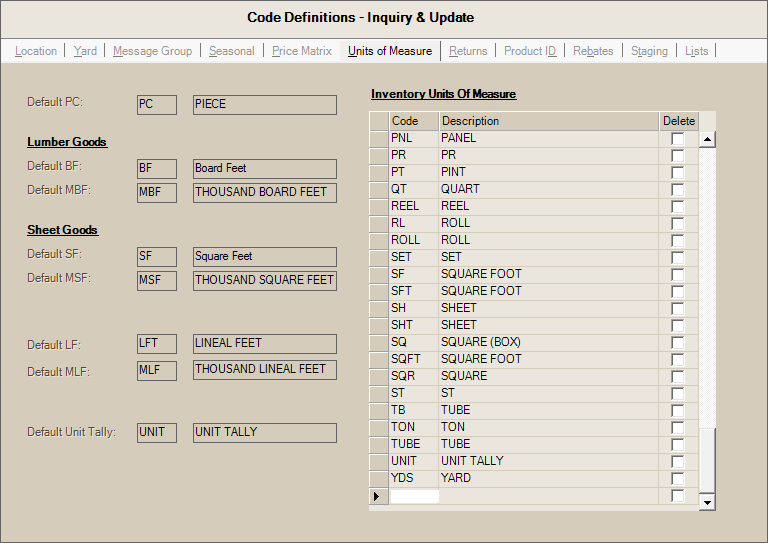Code Definitions > Units of Measure
This form is used for adding, modifying, and deleting Units of Measure. In addition, this area is also used for defining the defaults for new Lumber (Timber) and Sheet Goods items. Unlike other codes in this form, units of measure may not be added in Item Maintenance and must be defined here prior to being assigned to items or in other areas. Once added, units of measure can be associated with items and used in other areas.

Code Definitions
Units of Measure define how both quantities and pricing are represented for an item. There are 5 units of measure available: base, selling, receiving, pricing, and miscellaneous. The final 4 units of measure relate back to the BASE unit by a numeric relationship. For example, if an item's BASE measurement is set to EACH and the receiving measure is BOX, it's required to define how many EACH are in a BOX numerically:
1 BOX = 12 EACH
The same unit of measure cannot be defined with different values. For example, you cannot make 6 EACH = 1 EACH.
Measurements vary in complexity. Lumber (timber) is usually sold using measures based on volume and/or lineal length, for example. In the United States, board footage is a measure of volume that is commonly used with lumber because it makes commodity pricing more consistent. One board foot represents 144 cubic inches of wood (a 12" x 12" x 1" board). The quantity of board feet in each particular length varies, but when all the dimensions can be priced by a consistent measure of a board foot, the pricing stays consistent. When priced by board footage, an 8', 10', and 12' length of the same species of lumber would have the same or similar prices in terms of board foot (or more commonly thousand board feet... often referred to as MBF). In the United Kingdom, timber (lumber) is measured using a volume measurement based on a cubic metre (meter).
The term "lineal" refers to the measure of length only. Currently, the default lineal measure is only used with lineal tally items; however, even if you don't use these items, you will be required to save a measure if you enter the form and make other changes. In this case, just choose whichever measure would be used by your company for lineal lengths. The measure can be modified afterward should you want to change it.
Defaults for Lumber (Timber), Sheet Goods, and Lineal Tallies
When adding a lumber (timber), sheet goods, or lineal tally type item, default units of measure are listed and values assigned based on the dimensions entered by the user. In North America, this form can be used to define the units of measure for board footage, thousand board feet, square foot, and thousand square feet. In the United Kingdom, this form provides a way to set the default measures for cubic metre and square metre. In either case, the "Default LF" measure can be used to define the default lineal measure for lineal tally items (in the United States and Canada, lineal lengths are typically measured in feet; however, in the United Kingdom and in most other areas, metric values are used (metre, etc.)).
Default
If your company plans on using the Unit Tally feature, these measures must be defined. A "unit" measure may be optionally specified for unit tally type items, but is required for other reasons as well. The unit tally feature must be enabled from the Inventory tab of the Parameters form prior to use. A task list warning appears if the unit tally measure has not been defined upon processing any changes to the form.